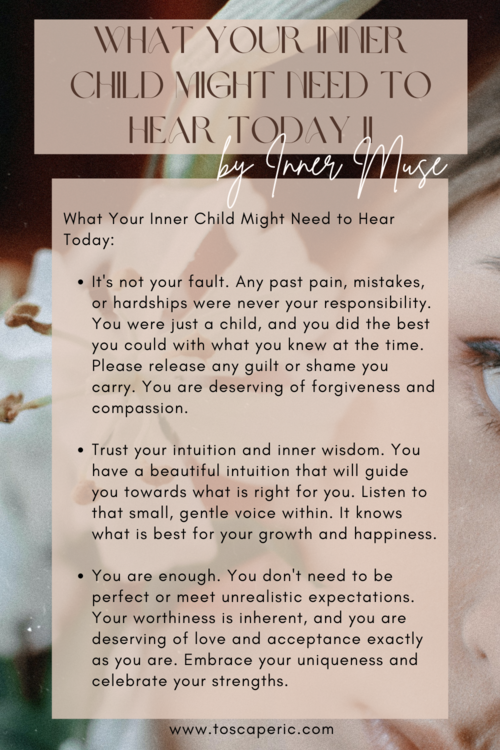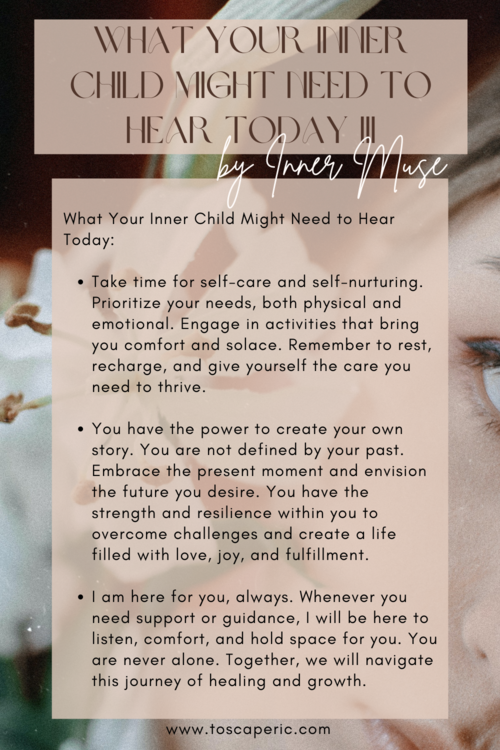I am Tosca
Welcome Goddess!
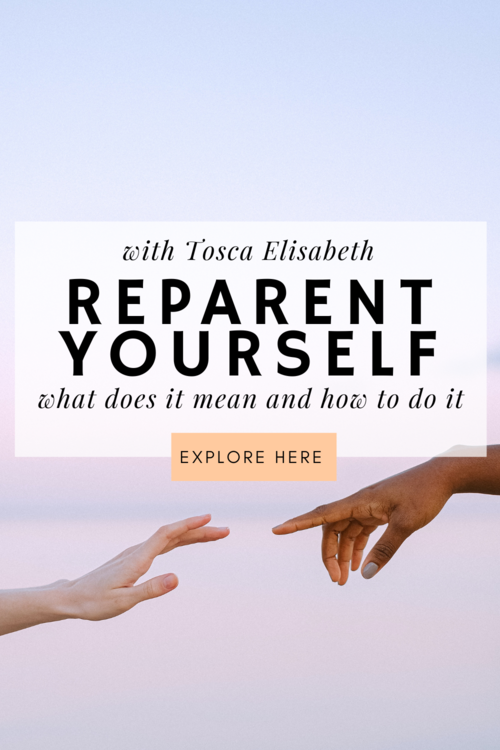
Reparent yourself: what does it mean and how to do it
Reparent yourself: what does it mean and how to do it
Each of us has had prior events that have shaped who we are now. It’s possible that some of these encounters were constructive while others weren’t. Reparenting yourself can be the key to realizing your full potential if you’ve been experiencing problems related to unresolved issues from your past.
Reparenting the Inner Child
What is the “Inner Child”
Life often carries wounds and scars from our past experiences, shaping who we are and how we navigate the world. Within each of us resides an inner child, a vulnerable and authentic aspect of ourselves that holds the memories, emotions, and beliefs from our early years. Inner child healing is a profound journey that allows us to reconnect with and nurture this wounded inner part, fostering deep healing and transformation.
The Essence of the Inner Child:
Our inner child is a reflection of our earliest selves, the innocent and unblemished version of who we were before the world’s demands and experiences altered our perception. This inner child carries our purest emotions, hopes, dreams, and fears, all of which continue to influence our behavior, relationships, and self-esteem as adults.
Unearthing the Wounds:
As we journey through life, we accumulate wounds from experiences that were painful, confusing, or overwhelming. These wounds may stem from childhood traumas, neglect, or unresolved conflicts. The unhealed wounds of our inner child can manifest as self-sabotaging patterns, low self-esteem, relationship challenges, or even physical symptoms.
The Healing Path:
Inner child healing is a profound process of acknowledging, validating, and healing these wounds. It involves creating a safe space to connect with our inner child’s emotions, allowing suppressed feelings to surface and be processed. Through techniques like journaling, meditation, creative expression, and therapy, we begin to understand our inner child’s needs and provide the love and support they may have missed during challenging times.
Benefits of Inner Child Healing:
- Emotional Liberation: Healing the inner child enables us to release pent-up emotions, fostering emotional freedom and authenticity.
- Self-Compassion: By nurturing our inner child, we learn to treat ourselves with kindness and self-compassion.
- Healthy Boundaries: Reconnecting with the inner child helps us establish healthy boundaries in relationships, safeguarding our emotional well-being.
- Transforming Patterns: Addressing unresolved wounds empowers us to break free from negative behavioral patterns that stem from the past.
- Enhanced Relationships: As we heal and understand ourselves, our connections with others deepen, fostering healthier and more fulfilling relationships.
The Inner Child and Self-Care:
Incorporating self-care practices into our daily lives is an essential aspect of inner child healing. Engaging in activities that bring joy, playfulness, and comfort is a powerful way to nurture our inner child’s needs. Whether it’s taking walks in nature, engaging in creative hobbies, or simply spending quality time with loved ones, these actions create a safe and supportive environment for our inner child to flourish.
Reparenting refers to the process of assuming parental responsibilities in your own life. It entails accepting responsibility for your own mental health and consciously deciding to improve your life. It’s about learning to accept and love yourself exactly as you are, as well as about mending the scars of the past.
Researchers have discovered that the vagus nerve is also essential in regulating our emotional and mental well-being because of its connection to the parasympathetic nervous system.
The following steps will assist you in reparenting yourself:
Acknowledge your past. Take some precious moments to sit with your memories, both the joyful and the challenging. Acknowledge that these experiences, whether they brought laughter or tears, have intricately woven together the tapestry of your being. Your past has played a significant role in shaping the person you are today, and while you can’t change the past, you have an incredible power: the power to change the course of your future.
Embrace the wisdom that your past holds. Those moments of triumph, however small, have instilled resilience within you. The hurdles you’ve overcome have fortified your spirit. Even the moments that may have left scars have given you the opportunity to heal, grow, and transform. As you reflect on your past, do so with gentleness. Allow yourself to feel the emotions that arise, and let them guide you towards a deeper understanding of yourself.
Remember, acknowledging your past is not about dwelling in it, but rather about recognizing the threads that have woven your story. By honoring your past, you’re honoring the journey that has led you to this present moment. From this place of acknowledgment, you can take the next step in your journey – the step towards consciously creating a future that aligns with your dreams, aspirations, and authentic self.
Let the lessons from your past empower you. Embrace your history as a guidepost, reminding you of the strength you carry within. As you embark on this transformative journey of self-discovery, recognize that the past is a chapter you’ve already written, while the future is an unwritten canvas awaiting your strokes of purpose and intention. With each step, you’re not just rewriting your story, but authoring a narrative that’s aligned with your truest essence and aspirations.

Discover your inner child
Beneath the layers of responsibilities and the roles we assume as adults, there exists a whimsical part of ourselves – our inner child. This inner child is a reservoir of innocence, curiosity, and unadulterated joy, reminiscent of the younger version of you. As we navigate the complexities of adulthood, we sometimes forget to nurture this precious aspect of who we are.
Take a journey back in time, into the realms of your childhood. Close your eyes and recall the memories of carefree play, boundless imagination, and unfettered laughter. What games did you love to play? What adventures did you dream of? As you unearth these memories, you also unveil the essence of your inner child.
Connecting with your inner child isn’t just about indulging in nostalgia; it’s about understanding the needs and desires that may have been overshadowed by the demands of adulthood. Your inner child longs for moments of spontaneity, for the thrill of discovery, and for the simple joys that ignite genuine happiness.
Spend time with your inner child. Engage in activities that once brought you sheer delight, whether it’s playing in the rain, drawing with crayons, or building sandcastles. Rekindle the sense of wonder that often gets buried under the layers of routine. Listen to the whispers of your inner child – what does it yearn for? What dreams were left unfinished?
As you nurture your inner child, you’re infusing your life with a renewed sense of vitality and authenticity. You’re giving yourself permission to be unapologetically you, to embrace the things that bring you joy without judgment. By tending to your inner child’s needs, you’re fostering a deeper connection with yourself, one that’s based on self-compassion and acceptance.
Incorporate your inner child’s desires into your life. It could be as simple as scheduling regular playdates with yourself, where you engage in activities that light up your spirit. By honoring your inner child, you’re creating a bridge between your past and present, infusing your life with the magic and enthusiasm of your younger self.
Remember, the journey to discovering your inner kid is an ongoing process of exploration and celebration. As you embrace this part of yourself, you’re inviting more authenticity, joy, and wonder into your life, enriching your relationship with yourself and those around you.
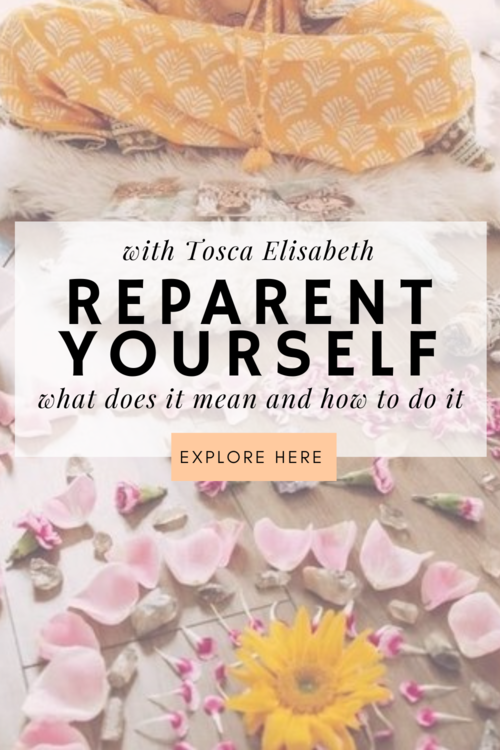
Set limitations and boundaries to reparent yourself. As you start to reclaim yourself, it’s essential to set boundaries with the people in your life. Make sure they are aware of your new restrictions and what you need and expect from them so that they feel at ease and supported.
Self-care is advisable. It takes a lot of self-care to reparent oneself. Spend some time alone to unwind, revitalize, and engage in enjoyable activities.
Look for expert assistance. Seeking the advice of a therapist or coach may be beneficial if you discover that you’re finding it difficult to reparent yourself. We can provide you with the resources and encouragement you need to recover and proceed. You can write me a personal email here or you can apply for 1:1 Coaching with me here.
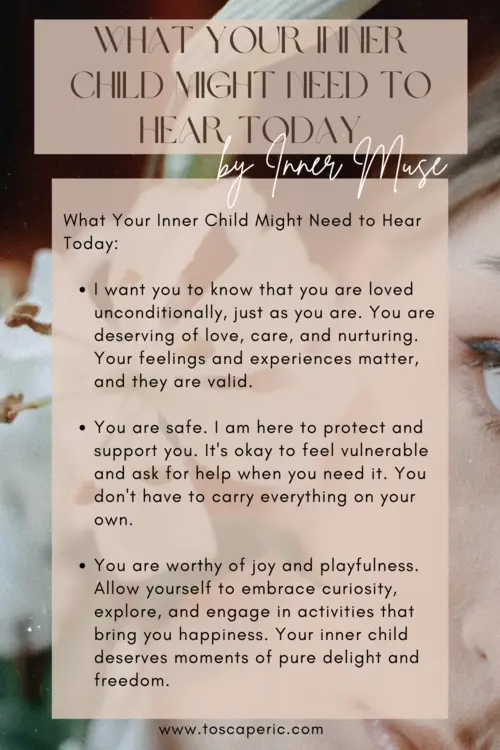
Self-reparenting is an incredibly impactful and transformative practice. Equipped with the right mindset and resources, you can embrace self-acceptance, nurture self-love, release the grip of the past, and pave a path to a brighter future.
However, let’s acknowledge that this journey demands time, patience, and unwavering dedication. As a coach, I strongly believe that self-reparenting stands as a cornerstone for personal growth and realizing your utmost potential.
If you’re ready to take this empowering step forward, I invite you to explore my website. There, you can delve deeper into the range of services I offer, gain insights about transformative retreats, and discover how I can guide you on your self-repair journey. Your transformative voyage begins here.
